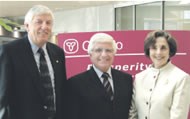
Researchers at Laurentian University are gearing up for a five-year, $24 million research initiativeto enhance productivity and manage risk in underground mining operations.
The Productivity Enhancement and Risk Management (PERM) project is being funded by an $8 million grant through the research excellence program of the Ontario Research Fund, as well as matching grants from industry and in-kind contributions.
The PERM initiative includes 11 projects falling under three distinct themes: design and construction of underground excavations, integrated planning, design and optimization, and water and waste management.
Projects in the first of the three themes will be led by Dr. Peter Kaiser, Professor of Mining Engineering and Chair for Rock Mechanics and Ground Control at Laurentian University. The projects will focus on innovative geomechanics design and support technology, seismic hazard reduction for deep mining and improved rock fragmentation. Research will also assist with the development of deep repositories for nuclear waste and more effective underground excavation in urban areas.
The second theme, focusing on integrated planning, design and optimization, will complement another $10 million Planning and Rapid Integrated Mine Optimization (PRIMO) project led by Dr. Paul Dunn, Director of the Mining Innovation, Rehabilitation and Applied Research Corporation’s (MIRARCO) Centre for Mining Technology.
PRIMO will adapt and integrate existing software into a single planning and scheduling framework to assist mining engineers in optimizing mine design and scheduling. The end result will be a semi-automated, integrated set of tools to provide engineers with multiple scenarios for better decision-making. Research under PERM, led by Dunn, will be aimed at integrating geomechanics data into the PRIMO software framework.
The third area of research, led by Dr. Graeme Spiers, Chair of the Centre for Environmental Monitoring Technology, will include projects focusing on remote monitoring technology, water resource management and solid waste treatment.
The research will “look at ways to operate mines without effluents, so there is a closed loop,” said Kaiser. Another project will explore the use of waste materials from the forest industry to build better cover for tailings.
With funding now in place, the next step is “to sit down with the companies that are interested in the projects to design the research programs and bring the key players together to make them a success,” said Kaiser, who is also executive director of the Sudbury-based Centre for Excellence in Mining Innovation (CEMI).
A year and a half ago, the University’s primary challenge was attracting dollars for research. The problem now is attracting graduate students to carry it out.
In addition to the $24 million PERM project and the $10 million PRIMO project (the latter is a combined effort of MIRARCO and AMIRA), CEMI has attracted funding of $20 million, half from the Ontario government and $5 million each from CVRD Inco and Xstrata Nickel.
“This is an absolutely unique and once in a lifetime opportunity to get involved in a level of research and development that you won’t have in mining anywhere else in Canada,” said Kaiser. “It’s a great opportunity to have an impact on the industry and how things are done, but we can only do it if we can attract the people to Northern Ontario to be part of it.”
In addition to mining engineers, Kaiser is hoping to attract information technology students, civil engineers and geologists to the University’s graduate studies programs. The University is also welcoming industry co-op arrangements whereby engineers, geologists and other professionals split their time between work and graduate studies to earn a Masters or Doctorate degree.
The $8 million grant from the Ontario Research Fund was part of a $115.5 million investment in research projects at 12 Ontario universities. Satisfying the criteria set by the Ontario Ministry of Research and Innovation for funding proved challenging because mining wasn’t specifically identified as a preferred focus for research.
“It’s like mining doesn’t exist,” said Kaiser. “Take any government document that comes out relating to research and scan it for mining. Data mining is the closest you get.”
In its application for the PERM initiative, Kaiser checked off “Advanced Manufacturing,” because the most complicated, most difficult manufacturing process in Canada is the manufacturing of ore.”
www.laurentian.ca



